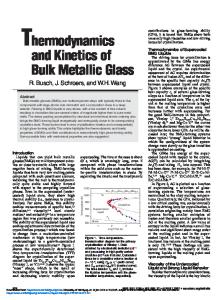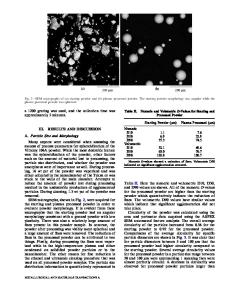Complex microshaping of bulk metallic glass surfaces by electrochemical means
- PDF / 526,505 Bytes
- 9 Pages / 584.957 x 782.986 pts Page_size
- 86 Downloads / 348 Views
Electrochemical micromachining (ECMM) with microtool electrodes is a promising method for microshaping bulk metallic glasses (BMGs) at room temperature. A key challenge is the control of the electrode reactions to impede the disturbing passive layer formation on machined surface regions. In the example case of a Fe-based glassy Fe65.5Cr4Mo4Ga4P12C5B5.5 alloy, it will be demonstrated that by using an aqueous electrolyte based on 0.1 M H2SO4 solution with up to 0.1 M Fe2(SO4)3 addition and by applying ultrashort voltage pulses, complex microstructures can be machined with high precision. Potentiodynamic polarization measurements reveal that the salt addition reduces the charge transfer resistance of the microtool and therefore, the negative bias potential effect. The free corrosion and passive state of the BMG workpiece are affected, but not the transpassive regime. Systematic ECMM studies were conducted to obtain optimum parameters for shaping complex lateral structures with very smooth and well-defined machining areas. I. INTRODUCTION
Over the last decades, the development of microelectromechanical systems has made a remarkable progress and the question arises, whether and how the also upcoming bulk metallic glasses (BMGs) with their promising properties can be used in this prospective growing field.1 Their very high strength and hardness make BMGs well suited for stressed parts in miniature motors or microdrives. Furthermore, several Fe-based glasses exhibit good soft magnetic properties,2 which also enable functional applications, e.g., as switchable parts in medical components, in micro-relays or as cores in miniature transformers.3 But how can these microscaled parts be manufactured under maintenance of the unique amorphous structure? A commonly used method to shape metallic glasses is micromoulding.4 But this thermomechanical technique is only applicable for glassy alloys, which exhibit a wide undercooled liquid regime at low temperatures and a large viscosity drop. Therefore, it is not employable for high strength Fe-based metallic glasses. Another possible technique is pulsed laser micromachining. It has been already demonstrated for several amorphous alloys,5 but the obtained machining accuracy and the surface finishing are not satisfying yet. Thus, an alternative low cost method is demanded, which operates at moderate temperatures and achieves submicrometer precision.
Contributing Editor: Edson Roberto Leite a) Address all correspondence to this author. e-mail: [email protected] DOI: 10.1557/jmr.2015.336 J. Mater. Res., Vol. 30, No. 22, Nov 27, 2015
http://journals.cambridge.org
Downloaded: 09 May 2016
A novel approach, which meets both criteria, is electrochemical micromachining (ECMM).6 A special ECMM technique using ultrashort voltage pulses and metallic microtools was introduced by Schuster et al.7 for microstructuring Cu parts with very high precision. Since then, its applicability has already been well proven for a wide range of crystalline materials, e.g., stainless steel,8 Ni,9 Ni-based all
Data Loading...











